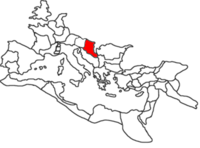Pannonia
|
|
Pannonia is an ancient country bounded north and east by the Danube, conterminous westward with Noricum and upper Italy, and southward with Dalmatia and upper Moesia. Pannonia was located in the territory of present-day countries: Austria, Croatia, Hungary, Serbia and Montenegro, Slovenia and Bosnia and Herzegovina.
Today, the term Pannonia is usually used for what is called Transdanubia (Dunántúl) in Hungary and for the northern parts of former Yugoslavia which are located in the Pannonian plain.
History
Its original inhabitants were the Pannonii (Pannonians), an Illyrian tribe. From the 4th century BC it was invaded by various Celtic tribes. Little is heard of Pannonia until 35 BC, when its inhabitants, allies of the Dalmatians, were attacked by Augustus, who conquered and occupied Siscia (Sisak). The country was not, however, definitely subdued until 9 BC, when it was incorporated with Illyria, the frontier of which was thus extended as far as the Danube.
In A.D. 7 the Pannonians, with the Dalmatians and other Illyrian tribes, revolted, and were overcome by Tiberius and Germanicus, after a hard-fought campaign which lasted for two years. The proximity of dangerous barbarian tribes (Quadi, Marcomanni) necessitated the presence of a large number of troops (seven legions in later times), and numerous fortresses were built on the bank of the Danube.
Balkans03.jpg
Some time between the years 102 and 107, between the first and second Dacian wars, Trajan divided the province into Pannonia superior (the western), and inferior (the eastern) portion. According to Ptolemy, these divisions were separated by a line drawn from Arrabona (Győr) in the north to Servitium (Gradiška) in the south; later, the boundary was placed farther east. The whole country was sometimes called the Pannonias (Pannoniae).
Pannonia superior was under the consular legate, who had formerly administered the single province, and had three legions under his control: Pannonia inferior at first under a praetorian legate with a single legion as garrison, after Marcus Aurelius under a consular legate, still with only one legion. The frontier on the Danube was protected by the establishment of the two colonies Aelia Mursia (Esse) and Aelia Aquincum (Alt-Ofen) by Hadrian.
Under Diocletian a fourfold division of the country was made:
- Pannonia Prima in the northwest, with capital in Savaria/Sabaria (Szombathely),
- Pannonia Valeria in the northeast, with capital in Sopiane (Pécs),
- Pannonia Savia in the southwest, with capital in Siscia (Sisak),
- Pannonia Secunda in the southeast, with capital in Sirmium (Sremska Mitrovica)
Diocletian also moved parts of today's Slovenia out of Pannonia and into Noricum.
The native settlements consisted of pagi (cantons) containing a number of vici (villages), the majority of the large towns being of Roman origin. Other than the aforementioned towns, there also existed the cities of:
- Scarbantia (Sopron)
- Arrabona (Győr)
- Gorsium-Herculia (Székesfehérvár)
- Mursa (Osijek)
- Cibalae (Vinkovci)
- Marsonia (Slavonski Brod)
- Taurunum (Zemun)
The country was fairly productive, especially after the great forests had been cleared by Probus and Galerius. Before that time timber had been one of its most important exports. Its chief agricultural products were oats and barley, from which the inhabitants brewed a kind of beer named sabaea. Vines and olive trees were little cultivated. Pannonia was also famous for its breed of hunting dogs. Although no mention is made of its mineral wealth by the ancients, it is probable that it contained iron and silver mines. Its chief rivers were the Dravus, Savus, and Arrabo, in addition to the Danuvius (less correctly, Danubius), into which the first three rivers flow.
In the middle of the 5th century Pannonia was ceded to the Huns by Theodosius II, and after the death of Attila successively passed into the hands of the Ostrogoths, Lombards, Avars (560's - c.800), Slavs (c.500 - 560's and c.800 - 900), Hungarians (since 900/901), Turks (since 1526), and Austrians (since 1699). After the First World War, the region was divided between Austria, Hungary and Yugoslavia.
The ancient name Pannonia is retained in the modern term Pannonian plain.
See also
Template:Roman provinces 120 ADde:Pannonien eo:Panonio fr:Pannonie it:Pannonia la:Pannonia hu:Pannónia nl:Pannonië pl:Panonia ro:Panonia ru:Паннония sr:Панонија

